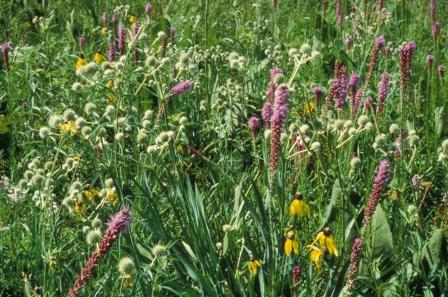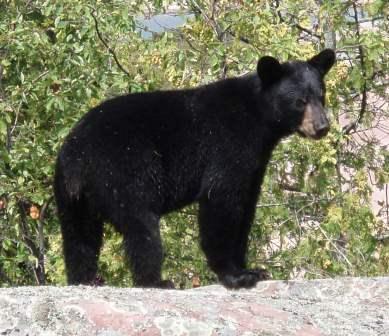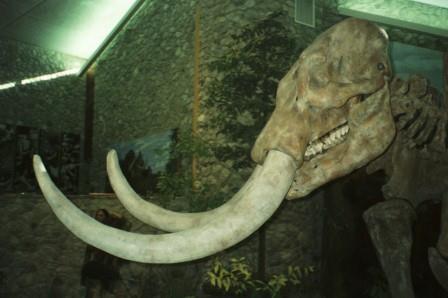by Carl Strang
This year’s winter series is a review of the prehistoric life and geologic history of northeast Illinois. Each chapter will summarize current understanding, gleaned from the literature, of what was going on with life on Earth in a particular span of time, what we know about the local landscape, and what we can say about local life. I include some references, particularly to papers published in the journal Science which commonly is available at public libraries. Contact me if you need sources for other items. The Earth is so old that every imaginable environment was here at some point, from ocean depths to mountaintops, from equatorial tropics to tundra, and from wetlands to desert.
Neogene Period (23.3 million years ago-present), Miocene Epoch (23.3-5.2 million years ago)
The Neogene Period (named in 1853) defines a time when a significant portion of fossil species (or at least very close relatives of them) still are in existence. The Miocene Epoch (established 1833), literally “few recent,” originally was defined by the percentage of then known fossil mollusk species still living (17%).
Life on Earth. Warming but continued dry conditions prevailed through most of the Miocene, giving way to renewed cooling in the late Miocene. This cooling was caused at least in part by the continuing growth of the Antarctic ice sheet. The resultant drop in sea level established land bridge connections from North America to South America and Asia. Continental growth, and also the rise of major mountain ranges, increased the seasonality of climate, and changed ocean circulation patterns, with upwelling zones probably setting up the conditions favoring pinniped (sea lion, etc.) evolution in the middle Miocene.
Grasslands spread in the Miocene. The Perissodactyla had been the dominant ungulates, with their diversity peaking in the Eocene, but in the Miocene they declined (though rhinoceroses remained prominent throughout the epoch), while the Artiodactyla increased. The latter ungulates’ advantage may have been their ruminant digestive tract and complex high-crowned teeth, good for grazers (this was true of the larger division of artiodactyls; the pigs and hippopotami lack these specializations). Camels were very diverse in the Miocene, a remarkable example being the 12-foot-tall, giraffe-like browser Aepycamelus.

Bactrian camels, Brookfield Zoo. The camels, which had their start in North America, were very diverse on our continent in the Miocene.
The deer family appeared early in the Miocene in the Old World. By the middle Miocene, the diversification and evolution of horses was represented in part by the first one-toed species, Pliohippus of North America. Horses did not develop high-crowned molars until 4 million years after the grasses replaced trees as the dominant vegetation in the Great Plains, but their limb structure changed more quickly, so that they were able to survive by efficiently traveling longer distances between suitable habitat patches (Science 306:1467). Ungulate diversity peaked in the mid-Miocene, perhaps because frequent disturbance by the large proboscideans (gomphotheres and mastodons, which migrated into North America at that time) diversified the grassland savanna that had developed. Toward the end of the Miocene, however, much of the savanna gave way to grasslands, and there were extinctions of many of these ungulates and proboscideans.

Prairies and other grassland ecosystems spread into North America and became important here in the Miocene.
The departure of forests from much of North America is associated with the vanishing of primates from this continent. Miocene land connections to South America and Asia resulted in significant immigrations and extinctions. Sabertooth cats and other Felidae first immigrated from Asia in the middle Miocene (ending the so-called “cat gap”). Other new Miocene arrivals from Asia included bears, skunks, and badgers; from South America, ground sloths. There was a diversification of canids (dog family), mustelids (weasel family) and amphicyonids, though in the late Miocene the amphicyonids became extinct. The American white-footed mouse genus Peromyscus first appeared in the Miocene, and Spermophilus ground squirrels in the middle Miocene. Flying squirrels had their start in Asia in the early Miocene, with the split between Old World and North American flying squirrels happening in the late Miocene. The dominant carnivores in South America were marsupials in the Tertiary through the Miocene. The first member of the opossum genus, Didelphis solimoensis, showed up in the fossil record of Brazil in the latter part of the Miocene. Marsupials went extinct in North America in the Miocene, however.

Bears evolved in the Old World, and crossed the Bering Sea land bridge into North America in the Miocene.
Modern bird families were established in the Miocene, and the land bird orders other than the passerines underwent their great diversification. The passerine (perching birds) explosion began in the late Miocene. The first modern genera of birds began to appear in the Miocene, as well.
Local landscape. Subtropical forest of the early Miocene gave way to warm temperate to cooler temperate forests. The Texas gulf coast was swampy, so our climate very likely was at least as moist as today. We were between known areas of forests in New England that were warm temperate (hickories, chestnuts, hollies, mulberries, gums, oaks, buckthorns, elms, grapes) and shrubland-savannas on the Plains (invaded by grasses and prairie forbs as the Miocene progressed). The closest Miocene deposits are in western Nebraska, south central South Dakota, central Mississippi and SW Maryland.
Local life. Throughout the Miocene, browser-grazer pairs of rhinoceroses were found all over North America in savanna environments (the most common genera were Aphelops and Teleoceras, respectively; Teleoceras appears to have been a herding, and possibly semiaquatic species). If our area was more forested, we may have had only a browsing species. Rhinos became extinct in North America at the end of the Miocene. It seems likely that our area witnessed the transition from perissodactyl to artiodactyl dominance. Forms of rhinos (5 genera), tapirs (2 genera), horses (14 genera), dromomerycids (an extinct group of deer-like woodland browsers with horned males) and camels (5 genera, including the giraffe-like Aepycamelus) probably were here. The oreodonts were a diverse group of pig-like herbivorous artiodactyls, with at least 4 genera probably here in the Miocene. Carnivora would have been the dominant predators (diverse dogs, weasels, the large bears Indarctos and Plionarctos, “bear-dogs,” large cats, and the saber-toothed nimravid Barbourofelis), but there was also the entelodont Dinohyus. The Miocene also saw the arrival of the first proboscideans, or elephant relatives. These may have had a significant impact, killing the trees that they fed on and thus disturbing the vegetation so as to create more habitat diversity. There likely were 3 genera here, including two that were relatively elephant-like, and one that had shovel-like lower tusks that it probably used both to scoop up aquatic plants and to scrape bark from trees.

